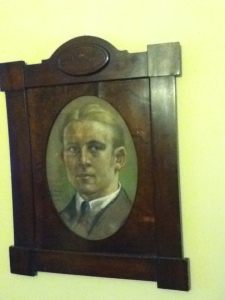I remember only one encounter with my grandad. I was four or five and he was standing at the end of a long hallway in a Victorian terraced house, bending down with his arms outstretched to greet me and chuckling delightedly as I ran into his arms. There were clearly many forgotten meetings before that, but few after it. He and my grandmother moved to the coast where he remained as an invalid for the rest of his short life, dying when I was nine.

Historical map with Bohemia proper outlined in pink, Moravia in yellow, and Austrian Silesia in orange. (Photo credit: Wikipedia)
As children we were simply told he was too ill to see us and our exotic Bohemian grandfather (that’s a geographical term, not a comment on his lifestyle) became a shadowy figure of mystery.
Grandad Oscar had arrived on these shores to seek his fortune at the beginning of the twentieth century. He was a barber-surgeon, possessing in his tool kit, amongst other things, an amputation saw and an amazing machine with dials and probes that produced some kind of early electro-therapy.
He seems to have wasted little time in sweeping the daughter of a London policeman off her feet and together they produced three sons in quick succession, the oldest being my dad.
As I understood it, when the First World War broke out, Grandad’s pronounced Germanic accent didn’t go down too well with the British authorities and he was interned for the duration of the War, leaving his young bride to rear the little boys alone and in considerable hardship.
Eventually the family was reunited and Dad told fond stories of how he accompanied his father on foraging trips in Epping Forest, collecting mushrooms, or of the hands-on healing skills he employed to relieve Dad’s migraines. It made me long to have known this gentle, sweet man for longer.
Something I’d all but forgotten was that a portrait of him as a young man, drawn in pastels, had been passed down to me by my father. In the manner of such heirlooms in bad novels and TV antique shows, it really had lain at the back of a garage for many years, swathed in bubble wrap.
 Yesterday, when the Ex arrived at the cottage with a car-full of my possessions, the portrait re-emerged. The frame had come loose, so we took the opportunity to prise it apart and examine the picture. Once the glass was removed and cleaned, I was able to see the image clearly for the first time.
Yesterday, when the Ex arrived at the cottage with a car-full of my possessions, the portrait re-emerged. The frame had come loose, so we took the opportunity to prise it apart and examine the picture. Once the glass was removed and cleaned, I was able to see the image clearly for the first time.
Quite apart from the time-slip sensation of staring into the eyes of my grandfather as a man around my son’s age, I was impressed with the skill of the artist.
Hidden beneath the frame was a signature: Lino Ve?co 1916. The letter in the centre of the surname was either a ‘g’ or an ‘s’. I Googled both.
A famous auction house had recently sold a landscape by Lino Vegco for a couple of hundred pounds. They’d clearly had the same problem we had in reading the signature.
Lino Vesco, however, appeared as an Austrian artist born in 1879. His pictures were selling for considerably more.This rather wonderful interior, for example, changed hands for over $3000.
 So how did my grandfather come to sit for so distinguished an artist?
So how did my grandfather come to sit for so distinguished an artist?
“He was your grandfather’s best friend,” my Ex informed my casually. “He did the portrait as a present.”
Apparently my father had shared this information with him, but neglected to tell my brother or myself.
Quite how it came to be drawn during the middle of the war, when Grandad was in a prison camp, I’m not sure, but still.
The next mystery was the ornate frame. The carefully carved oval at the top has a strange inscription. This really is sounding more like a cheap detective story by the minute, don’t you think?
 Here’s a very blurred image of the inscription, to give you a general idea.
Here’s a very blurred image of the inscription, to give you a general idea.
I hadn’t a clue what language it was in, let alone what it said. My son, having done some searches of his own, tells me it’s Arabic and seems to be a name – Arno Lawrence being the most likely translation.
I wish I could end this post by explaining the link. I fear it will forever remain a mystery. (Although yet another Google search revealed that around a hundred years ago DH Lawrence was staying in a room overlooking the River Arno and that TE Lawrence – Lawrence of Arabia – was fighting in Arab lands…)
Hmm.
Perhaps one day, when time and funds allow, I’ll try researching my family tree and discover more about this grandfather I barely knew and his friends. For now though, although mystery will continue to surround him, I will enjoy our new-found connection as he gazes thoughtfully down at me from the wall of my living room in Lime Cottage.